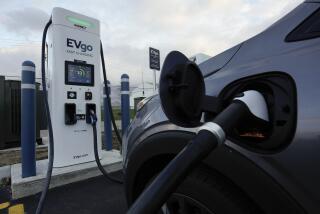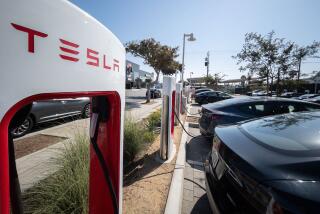With gas prices rising, first electric vehicle owners are charged up
Gas prices are rising, and drivers are fretting. But not Roy Olson.
The Rancho Mirage retiree drives a plug-in hybrid electric Chevrolet Volt, which he said runs for about 40 miles on battery before switching to traditional fuel. Because he charges the car nightly, Olson has yet to visit a gas station.
“Having our future in our own hands is really important,” he said. “I’m insulated from what’s going on in the Middle East. If I had to pick one reason for getting this car, that’s probably No. 1.”
Olson is part of a small group of auto fanatics, environmentalists and technology enthusiasts who bought the first batch of Volts and Nissan’s all-electric Leafs that rolled out in December. So far, several hundred have reached drivers, including talk show host Jay Leno and actress Alyssa Milano, with tens of thousands on waiting lists.
Chevrolet has sold fewer than 1,000 Volts; the number for the Leaf is about 200. Chevrolet and Nissan said they expected sales to grow as they ramp up production this year. Even so, the cars will barely register among the 13 million vehicles Americans are expected to purchase this year.
The early adopters are no longer wringing their hands over their decision to be the first to drive the vehicles.
“I could have looked very sensible or very dumb in the decision to buy this car,” said Michael J. Walsh of his new ocean blue Leaf. “It’s looking like the former.”
Even if gas hits $5 a gallon, electricity rates for charging won’t change much, he said, and drivers dependent on foreign oil — and vulnerable to foreign conflicts — may start to covet the battery-powered cars they once mocked.
“We’re at the tip of the spear,” said Walsh, 49, of Garden Grove. “First, people will cut back on driving, and then they’ll look for alternatives.”
But cruising around in an electric vehicle hasn’t been an entirely smooth ride. Drivers have reported difficulty with home and public charging systems and have trimmed travel plans because of limited battery range.
The cars aren’t cheap. Olson nearly got sticker shock from the Volt’s price tag: $40,000 before government incentives that shaved $7,500 off the cost.
Same for Walsh and his Leaf, with a sticker price of $34,000 before incentives. “The economy is iffy, and we already had another car that’s working fine,” he said. “It probably doesn’t make any financial sense whatsoever. But then again, this is a purely green purchase.”
Walsh, a self-described technology geek, thought his early-adopter days were over after he “got burned” buying massive satellite dishes and $1,600 brick-size cellphones that quickly grew outdated. But still he longed for an electric vehicle.
The $100,000 Tesla Roadster was out of his price range. He nixed the Volt and the Toyota Prius hybrid because both used fossil fuels. He considered retrofitting an existing car or importing an electric vehicle from abroad.
Then came the Leaf, one of the first mass marketed all-electric cars for sale from a major automaker.
“It was something I had to be a part of right away,” Walsh said. “Even 15 years ago, I realized that EVs were going to be the next big thing, the Car 2.0.”
Some drivers remember the last brief heyday of electric cars, with the debut of General Motors’ EV1 in 1996. But the program was scrapped in 1999, and the cars were crushed because of low demand, according to the automaker.
This time around, most early adopters of electric vehicles are hoping for a better reception.
President Obama wants 1 million such vehicles on the road by 2015. Automakers — including Honda, Toyota and Mitsubishi — are scrambling to roll out electric models.
“For new technology to succeed, it can’t be equal — it has to be better,” said Leno, who has driven his Volt more than 1,200 miles and featured an electric Ford Focus on his NBC show.
Battery-powered vehicles could turn gas guzzlers into recreational curiosities, he joked, “like snowmobiles — something for the guys to drive around on the weekends.”
First though, automakers must win over American drivers who are wary of expensive and potentially fickle batteries. Consumer Reports found last week that in cold weather, the Volt’s battery lasted just 23 to 28 miles instead of up to 40 as Chevrolet had estimated.
“It’s not really much of a money saver in many places,” reviewers concluded. “Cheaper electricity or more expensive gas could tip the scales in its favor. For now, it seems that owning a Volt is an expensive way to be green.”
Local communities will likely need to make building public charging stations a priority before electric vehicles catch on with the masses.
Walsh said he knew of just a few public charging stations scattered at Nissan dealerships. At home, he has a charger in his garage timed for cheaper night charging. He carries a modified portable unit to juice up at the Hawthorne aerospace company at which he works.
Nissan says its Leaf battery lasts 100 miles per charge, so Walsh must be diligent about planning his schedule around his 60-mile roundtrip commute. He can usually afford a short lunch trip but rations air conditioning because it depletes the battery more quickly.
Walsh said he wouldn’t buy another electric car unless it could make it to Las Vegas on one charge.
“It’s not range anxiety nor an inconvenience, just an awareness of what I have to do,” he said. “But I haven’t pushed the envelope too much.”
Olson said he ran into kinks at home, where he wanted a 240-volt charger that would power up the car in four hours. He ended up with a slower 120-volt system that he set up himself after delays with the installation company.
He also wanted to install a dedicated electric meter for the car, which would have charged it at a discounted rate. But Southern California Edison lagged when setting up an inspection of his home’swiring, Olson said, so he decided to power the Volt with the meter he uses for the rest of his house.
“SCE talks a good game, but they need to be better about making it easier for people with EVs,” he said.
Customers prepping their homes for electric vehicles should be prepared for complex situations, said Steven Powell, manager of the utility’s plug-in electric vehicle readiness program. The process has many moving parts: homeowner associations, electricians, permitting agencies and more.
“Some may have a home that’s not up to code,” Powell said. “Or the electrical panel may not have enough capacity available to accommodate charging at the level they want. Unfortunately, some customers will end up in situations where the full options aren’t available to them.”
Aside from installation kinks, so far so good, Olson said. His iPhone can access the Volt’s owner’s manual, unlock the car, start it remotely and send him reminder texts about charging. And though his Volt is neither fast nor flashy, Olson said, the unassuming car is quieter than a bicycle and stays cool with its silver coat of paint.
Even his wife has come around.
“Now, she drives it most of the time and calls it her car,” he said. “Just shows that you’ve got to be willing to take a chance on things.”
Times staff writer Jerry Hirsch contributed to this report.







